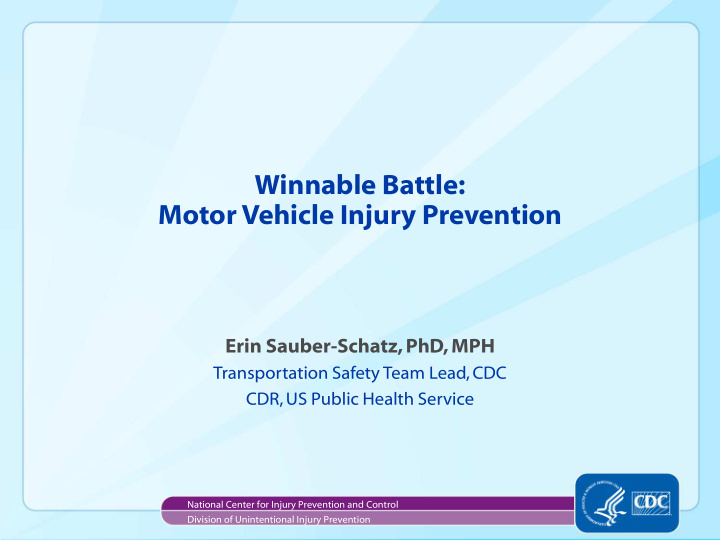



Winnable Battle: Motor Vehicle Injury Prevention Erin Sauber-Schatz, PhD, MPH Transportation Safety Team Lead, CDC CDR, US Public Health Service National Center for Injury Prevention and Control Division of Unintentional Injury Prevention
Resources CDC’s MV PICCS http://www.cdc.gov/motorvehiclesafety/calculator/ CDC’s State Based Fact Sheets http://www.cdc.gov/motorvehiclesafety/impaired_driving/states.html http://www.cdc.gov/motorvehiclesafety/seatbelts/states.html https://www.cdc.gov/motorvehiclesafety/statecosts/ CDC’s Prevention Status Report http://www.cdc.gov/psr/
Resources Tribal Toolkit http://www.cdc.gov/motorvehiclesafety/native/toolkit.html The Community Guide http://www.thecommunityguide.org/mvoi/index.html NHTSA’s Countermeasures that Work http://www.nhtsa.gov/staticfiles/nti/pdf/812202- CountermeasuresThatWork8th.pdf
RESEARCH
The Predictive Influence of Youth Assets on Drinking and Driving Behaviors in Adolescence and Young Adulthood. The Journal of Primary Prevention. Drinking and driving among adolescents and young adults remains a significant public health burden. The most important and consistent protective factor drinking and driving and riding with a drinking driver over time was parental monitoring. This study highlights the role of parental influence beyond the immediate teen driving context and into young adulthood. Teens and Seat Belt Use: What Makes Them Click? This CDC study provides the most comprehensive state-level estimates to date of seat belt use among U.S. teens. Seat belt use was 11 percentage points lower in states with secondary enforcement seat belt laws compared to states with primary enforcement laws. Racial/ethnic minorities and substance-using teens were least likely to always buckle up. Results suggest that environmental influences can compound individual risk factors, contributing to even lower seat belt use among some subgroups
Who's Not Driving among U.S. High School Seniors: A Closer Look at Race/ethnicity, Socioeconomic Factors and Driving Status. Driving status varied considerably by student academic performance, number of parents in the household, parental education, census region and urbanicity. Many young people from minority or lower socioeconomic families who learn to drive may be doing so after their 18th birthday and, therefore, have not benefited from having transitioned through a graduated driver licensing system. Innovative approaches may be needed to improve safety for these young novice drivers.
COMING SOON RESEARCH AND RESOURCES
Vital Signs: Motor Vehicle Injury Prevention 2015 projected increase in the number of deaths Reassess where we are in the US and what we can do to make more progress Role of Attitude Toward Seat Belts As a Predictor of Seat Belt Use, By Seating Position Graduated Driver Licensing Night Driving Restrictions and Fatal Night Crashes — 40 States, 2009 – 2014 Mandating Treatment Based on Interlock Performance: Evidence for Effectiveness Bicycle Helmet Use among Persons 5 Years and Older in the US Best Practices Guide: Tribal Motor Vehicle Injury Prevention Programs
Recommend
More recommend